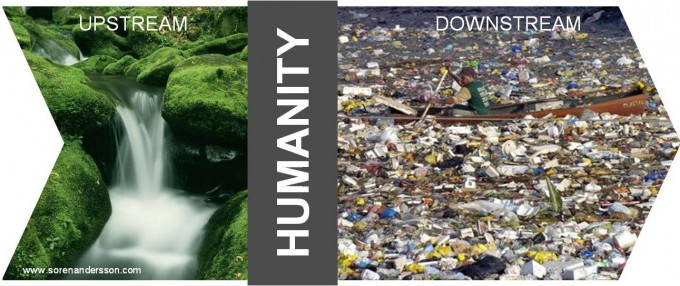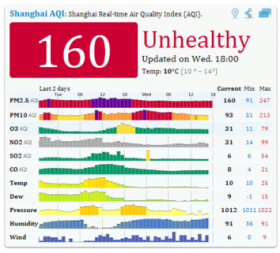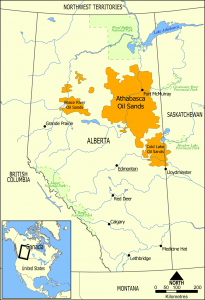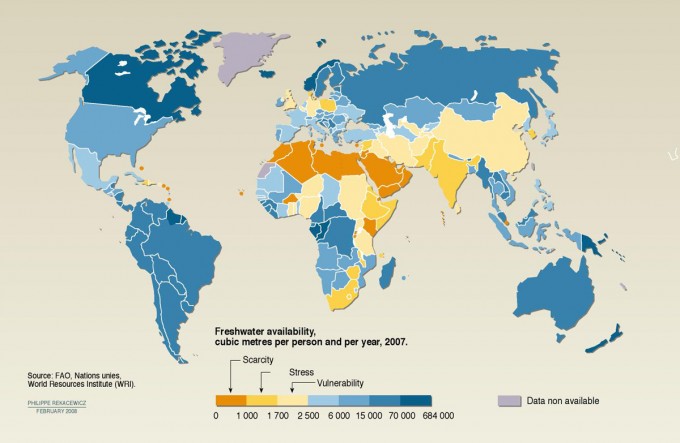
Except maybe for a very small amount of indigenous people, we all live downstream of human activity – a fact that makes it even more incomprehensible – The way we treat our planet…
 We are getting used to air-pollution alarms coming from China practically every day – a couple of weeks ago I met with a friend currently living in Shanghai, he showed me the “App” he was using on a daily basis, to monitor the actual level of pollution.
We are getting used to air-pollution alarms coming from China practically every day – a couple of weeks ago I met with a friend currently living in Shanghai, he showed me the “App” he was using on a daily basis, to monitor the actual level of pollution.
…I looked at my own phone and the weather-app telling me if it is Sunny or Windy and what temperature I need to “worry” about [!]…
Last week it was Paris suffering from smog, with pollution levels far exceeding the WHO-standards, forcing officials to introduce free public transport, including cycle and electric car-sharing schemes and regulations that drivers may only use their cars on alternate days, according to the odd or even numbers on their licence plates.
But there is more to Living “Downstream” – Much more…
Better without us…
Let’s face it – the planet doesn’t need us, in fact it probably would do much better without us.
 A hundred years ago, with a population of less than 2 Billion perhaps the planet could cope with some of our “foolish and destructive behaviour”, but with a population of soon 9 Billion the scale of our impact is no longer within the planetary boundaries.
A hundred years ago, with a population of less than 2 Billion perhaps the planet could cope with some of our “foolish and destructive behaviour”, but with a population of soon 9 Billion the scale of our impact is no longer within the planetary boundaries.
We tend to hear or read about how we treat our planet in small fractions here and there, often with only basic information about total impact and very seldom connected with other “events” – let’s make a short odyssey through some…
Exploitation of resources
Mountaintop removal
 Just listen to the “phrase” – mining corporations literally “blast away” mountaintops that have taken more than 300 million years to form, to excavate coal and then burn it to get energy – causing enormous amounts of CO2-emissions, coal-dust and multiple other environmental damages along the line. Not forgetting the huge scars in nature and ecology.
Just listen to the “phrase” – mining corporations literally “blast away” mountaintops that have taken more than 300 million years to form, to excavate coal and then burn it to get energy – causing enormous amounts of CO2-emissions, coal-dust and multiple other environmental damages along the line. Not forgetting the huge scars in nature and ecology.
Only in the Appalachian region in the east of US, more than 2,000 sq km (800 sq mi) have been “removed” – an area the size of Luxembourg or equal to 2.5 times the total area of the five boroughs of New York… and in the rest of the world…?
Tar-Sands
 In Alberta, Canada and in other places huge areas are being devastated due to extraction of bitumen, that can later be refined to crude oil. Extraction is done as open strip-mining or with various techniques injecting huge amounts of water (steam) and chemicals into the ground.
In Alberta, Canada and in other places huge areas are being devastated due to extraction of bitumen, that can later be refined to crude oil. Extraction is done as open strip-mining or with various techniques injecting huge amounts of water (steam) and chemicals into the ground.
Effects on the landscape, environment and society are colossal. (Link to previous article)
The extraction is not only destroying the landscape – the GHG-effects from the oil is 12-22% higher than from “conventional” oil, causing huge amounts of CO2-emissions…
Only the deposits of north-western Alberta cover 140,000 sq km (54,000 sq mi) – an area larger than England or almost the size of Iowa.
Water
I live close to the ocean, if I tell anyone, standing at the shoreline, that water is a scarce resource it is very easy to be dismissed – the ocean is vast… at least we thought so…
(Link to previous article “Clean Water – a scarce resource“)
- All Earth’s Water
All the water in the oceans, ice caps, lakes, and rivers, as well as groundwater, atmospheric water, and even the water in you, your dog, and your tomato plant. - Liquid freshwater – 2,5 %
The world’s liquid fresh water (groundwater, lakes, swamp water, and rivers), of which 99 % is groundwater, much of which is not accessible to humans - Freshwater in lakes and rivers – 0,3 %
Fresh water in all the lakes and rivers on the planet, and most of the water people and life of earth need every day comes from these surface-water sources. The volume of this sphere is about 93,113 cubic kilometers.
Great Pacific Garbage Patch
…what an invigorating “phrase”…

Plastic from the Pacific outside Easter-Island
The United Nations Environment Program (UNEP) estimated in 2006 that every square mile of ocean hosts 46,000 pieces of floating plastic. In some areas, the amount of plastic outweighs the amount of plankton by a ratio of six to one. Of the more than 123 billion kilograms (or 270 billion pounds) of plastic the world produces each year, about 10 percent ends up in the ocean.
Scientists have collected up to 750,000 bits [!] of plastic in a single square kilometre (or 1.9 million bits per square mile) of the Great Pacific Garbage Patch. Read more about the “Pacific Trash Vortex” at Wikipedia [Link) at National Geographic [Link], or at Greenpeace [Link]
…imagine that we could pollute something so vast and beautiful in only a few decades, mainly since the 1950s, and that seabirds and fish get their stomachs filled with plastic items such as bottle tops, lighters, balloons and high concentrations of other plastic particles – I wonder if fish feeding on petrochemical synthetic polymers with all kinds of chemical additives is equal to “healthy food”… and what about all other toxic waste, oilspill, fertilizers etc that we pour into the ocean…
Water Scarcity
Freshwater is a limited resource – when you add how it is distributed around the world, the geological and climatic parameters to the equation it becomes a very complex situation.
Freshwater availability

Already today, every year 150 cubic kilometres total volume of groundwater, equal to 100 million Olympic-size swimming pools[!] is being overpumped or withdrawn quicker than it can be replaced from underground aquifers, a tripling in less than 50 years.
Water use

- Direct Water Use – Water consumed on a daily basis
- Indirect Water Use – Water required to grow and manufacture a product or a service.
If you compare “Water use” with the “Freshwater Availability Map” and then add factors such as; Where will population growth, +2 Billion until 2050, occur and also add where in the world the population is moving the fastest up the food chain towards a more “western-style” consumption pattern, including more meat, chocolate, wine, coffee, clothes etc…
It becomes quite obvious that there is a problem…
…any risk that Climate change is adding a higher risk of Drought to the equation?
GMO
Genetic Modified Organisms
 Most genetic changes through evolution have happened over several decades, centuries our even thousands of years – until this one species have decided to become the “top-designer” with the ultimate knowledge and governance on how everything is interconnected – an absolutely terrifying idea, especially with the track record accomplished so far…
Most genetic changes through evolution have happened over several decades, centuries our even thousands of years – until this one species have decided to become the “top-designer” with the ultimate knowledge and governance on how everything is interconnected – an absolutely terrifying idea, especially with the track record accomplished so far…
Just the fact that one of the main Pro-GMO Corporations is also the one behind products such as PCB, DDT, Dioxin, Round-Up, Agent Orange and several others is not very reassuring – link to “Monsanto Dirty Dozen”
And what about Testing – how do you test effects from modified organisms that have never existed before… and where effects may linger for decades and generations. What about the “Precautionary Principle” – isn’t “GMO” a field where it should be an absolute prerequisite? Judging from how this is handled today, apparently NOT – “fiddling around” with what is probably the most important basic “building-bricks” to ALL life on our planet seems to be almost “fair game” to any corporation…
Maybe we should ask people “living” Downstream any of the products mentioned above for their opinion…
If you to this add the fact that our current “flawed” corporate system is founded on theories stating that “Business as a whole cannot be said to have responsibilities” (Link to previous article) – then it’s quite clear that we have a problem…
Ecology
 I am one of the lucky guys who seldom gets a bee-sting – It’s something about a smell or something – but on the other hand, if we continue to use pesticides such as Neonicotinoids none of us will suffer bee-stings anymore – there will be no bees around…
I am one of the lucky guys who seldom gets a bee-sting – It’s something about a smell or something – but on the other hand, if we continue to use pesticides such as Neonicotinoids none of us will suffer bee-stings anymore – there will be no bees around…
…what’s worse is that there are a number of other matters that will be affected by a “Pollinator decline” – just take a look at this List…
Did you recognize any of the plants on the list…?
If plants are no longer being pollinated they eventually cease to exist.
This is what will happen when we interfere with the extremely complex and intricate system we call “Nature” – the effects to our “food-chains” and other interconnections are incalculable…
“A study from North Carolina University found that the neonicotinoid ‘Terraguard’ and the fungicide ‘Procure’ had synergistic affects when combined, increasing the danger of the neonicotinoid to honeybees to over 1,000 times its original toxicity. The researchers at Penn State are concerned that even sub-lethal doses of these pesticides, while not killing the bees, are impairing their behaviour and suppressing their immune systems.”
…and yet – more pesticides and fungicides are being used today than ever before, and increasing – there are even companies doing GMO-modification so that plants are resistant to pesticides, allowing more and stronger versions to be used…
…the list just goes on and on – and I have barely touched the subject of CO2-emissions – probably the worst of them all…
Complexity
 One of the most difficult issues, is the complexity of it all – no one knows what kind of “cocktail” of pesticides and other chemicals our planet and humans are exposed to, no one really knows how different “disturbances” to our ecology interconnect – each manufacturer claims that they are only responsible for their specific product or service…and then of course, being a corporation means that “Business as a whole cannot be said to have responsibilities” (Link to previous article)
One of the most difficult issues, is the complexity of it all – no one knows what kind of “cocktail” of pesticides and other chemicals our planet and humans are exposed to, no one really knows how different “disturbances” to our ecology interconnect – each manufacturer claims that they are only responsible for their specific product or service…and then of course, being a corporation means that “Business as a whole cannot be said to have responsibilities” (Link to previous article)
And it’s continuing in more or less the same fashion when we are now increasing demands on corporations to be more transparent and reveal more sustainability-parameters – “most companies are instead seeking to take the simplest route by measuring the easiest to reach aspects of their supply chains” Link to previous article.
Legality
Quite often when these matters are discussed someone comes dragging with excuses such as “it’s a Free market” (Link to article), “We are only acting inside the legal system” or “it’s not illegal”…
The list of issues where we are exploiting the earth’s resources beyond wit and senses is very, very long, almost endless – Who are we to decide that we have the sole rights to destroy the very foundation for existence on this planet… “legally or illegally”
…we condemn dictators and others who are guilty of mass murder or genocide…
Which corporate executive has the exclusive right to decide on matters critical to human survival – by himself or even in the board-room…
“No man is an island, entire of itself; every man is a piece of the continent.”
John Donne (1572-1631)
… there is much more at stake here than any legal system can encompass, it is a question about Ethics and Moral… and Survival…
And never forget, Rich people, Poor people, You, Me, our Childrens and Future generations –
